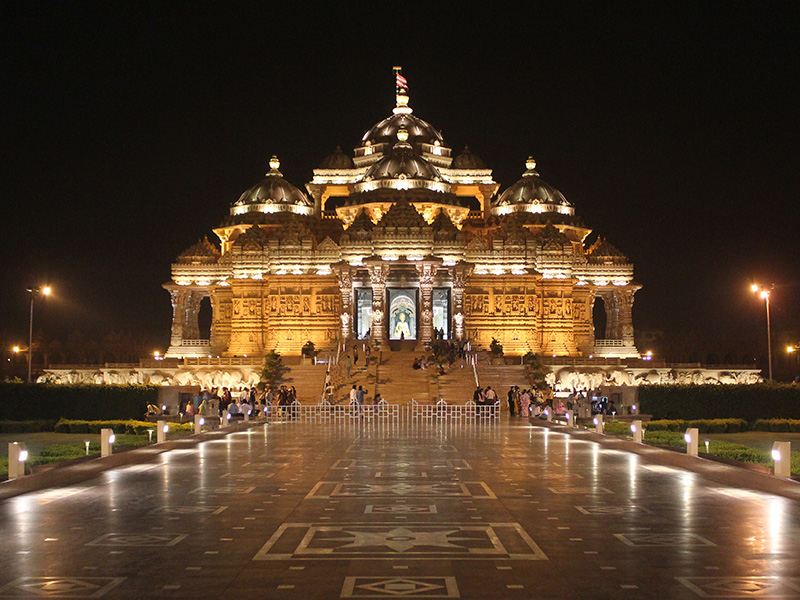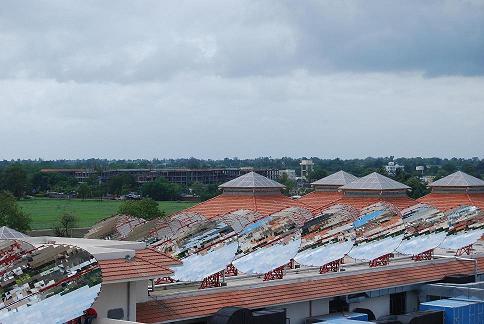Places of worship in India, from mosques to temples to churches, are making a green statement by using solar photovoltaic energy to power prayers across the country.
“It was a bold decision. We were quite startled to find a masjid that wanted to go solar. It has now become a trendsetter in the community,” said Sohail Sheikh of Green Power Consortium Management (GPCM). “There are an ample number of donors for mosques in Mumbai who normally provide funds for initiatives like installing air-conditioners.”

He was referring to the Minara Masjid, which is one of a slew of solar photovoltaic (SPV) power projects that he has installed in Mumbai mosques, challenging the image of such religious institutions being run by dyed-in-the-wool conservatives who are reluctant to change and adopt cutting-edge technologies.
The power generated during the day by the plant is used for its own needs and the excess sent back to the grid, which would be redeemed in the monthly bill against the units consumed by the Brihanmumbai Electric Supply & Transport Undertaking (BEST) at night. The masjid (mosque) was earlier procuring electricity for INR 14.85 (USD 0.23) per unit, whereas it can now produce its own electricity at an average cost of INR 3, which will remain unchanged for 25 years. “The masjid will reduce its carbon footprint by 11.3 tonnes every year and shall save electricity worth INR 3 lakhs (300,000) annually,” Sheikh said.
There was a time when environmentalists would seek the involvement of religious institutions to spread the green message, considering that they attract a large number of devotees. They often proposed that pilgrims to the Himalayas, for instance, could plant trees along the denuded slopes. But, of late, such institutions and individuals have adopted solar and other renewable technologies on their own, altering the conventional belief that these are blinkered by their religious zeal and have no time for worldly concerns like climate change.
Powering prayers
The examples of religious places going for green energy are spread across the country. Auroville near Puducherry is said to have the highest concentration of renewable energy systems in the country. It has 484 PV modules with a total capacity of 36.3 kW at the Matrimandir, a meditation centre which lies at the heart of the township. The plant is believed to be the largest standalone system in India.

The Akshardham Temple in New Delhi has a concentrator solar dish at its kitchen where 4,000 meals are cooked every day. The dish heats water to generate steam to cook food. The receiver is designed to operate at temperatures up to 400 degrees Celsius and works as a solar boiler, making it an effective replacement for conventional polluting fuels such as furnace oil, diesel and coal.

The Shirdi Sai temple, near Nashik in Maharashtra, which draws thousands of devotees every day, has one of the world’s largest solar cooking systems installed at its Sai Prasadalaya, a community kitchen. Around 70 solar reflectors, each spanning 16 sq. metres, are mounted on the rooftop. These dishes concentrate sunlight on receivers that contain water, generating steam that is piped down to the kitchen for cooking 42,000 meals per day for 25,000 people. More than two tonnes of rice are cooked with this plant every day, saving cooking gas up to Rs 20,000. Till date, the plant has saved INR 6 million for the trust.
The World Renewal Spiritual Trust (WRST), a sister organisation of the Brahma Kumaris and also a solar research centre, is setting up a 1 MW solar thermal power plant to demonstrate the advantages of this alternative technology in Abu Road, Rajasthan.
After evaluating various solar technologies, it decided to use its in-house developed 60 sq. metre parabolic dish to set up a solar thermal power plant near its Shantivan Campus. The plant will be the first of its kind in the world in dish technology to directly produce steam.
Green Power has installed panels in three other mosques in Mumbai. One is the 204-year-old Zakaria masjid in the congested Masjid Bunder area in south Mumbai. The 150-year-old Hashemiah High School — the city’s oldest Urdu medium school — adjacent to the mosque has installed an INR 1 million SPV project with a 10 kWp capacity.
As many as 36 solar panels have been installed at the mosque, and 12 atop the school. The solar panels are installed on an elevated frame and not only generate electricity but also provide shade to the 200-odd devotees who visit every day.
The 75 units generated at the site power lights, fans and air-conditioners. The monthly electricity bill has dropped by a fifth, a savings of INR 154,000 a year, according to members of the Zakaria Masjid trust. “Apart from being cost-effective, we are able to spread the message of protecting the environment by adopting this renewable form of energy,” according to Irshad Lakdawala, chairperson of the trust.
The Jumma masjid near Mangaldas market, Kalbadevi, has a 31 kWp scheme. A smaller 15 kWp project has been installed at the Ansar masjid in the Santa Cruz suburb, while another in Mumbra just outside the city proper has twice that capacity. Maharashtra College, which serves the Muslim community, has installed a 50 kWp project.
The Sacred Heart school in Vashi, in Navi Mumbai, has installed a INR 1.7 million project which, according to Gerry Fernandes, the parish priest of St John Baptist Church in the outlying township of Thane, which has been selected as one of the Central government’s Solar Mission Cities, brought down its monthly bill from INR 45,000 to INR 4,000.”We have seen the difference,” he told indiaclimatedialogue.net.
Solar trend
The trend is catching on in the rest of the country. India’s first all-women Ambar mosque, now 20 years old, in Lucknow, the capital of Uttar Pradesh, runs fully on sun power through a 1 kWp rooftop installation put by 8minutenergy, the largest independent solar power developer in the US with a solar project portfolio of 7,500 MW.
Temples aren’t lagging behind. The latest is Shree Ayyappa temple in Thane, which inaugurated its 41-panel 12.951 kWp rooftop scheme this October. The temple straddles an area of 6,000 sq. metres, which makes it an ideal candidate for this renewable technology. It generates 54 units a day — seven times what a two-bedroom apartment would need — to meet its entire electricity needs in a year.
“The temple authorities got to hear about our company, which is only one year old, through word of mouth. It took two months to procure the panels and install them,” Animesh Manek of Avishakti Rooftop Solar told indiaclimatedialogue.net. “The payback will be within three years.”
Prior to this, Manek launched a project at Shri Krishna Pranami Mandir temple in Bhuleshwar, one of the most congested areas of Mumbai. It is a 8.5 kWp project with 27 panels, generating 34 to 45 units a day, depending on the time of the day. The temple saves INR 1.45 lakh a year by not paying for this electricity. The government provided a subsidy of INR 150,000 for this project.
The pioneer in Mumbai was the 200-year-old Shree Siddhivinayak Ganpati temple in midtown Prabhadevi, whose 72-panel project has shaved INR 40,000 off its huge electricity bill of INR 700,000 a month a since it was installed four years ago. They are spread across 3,000 sq. ft above the five floors of the building.
“We are employing a new technology where we paste lighter cells on the roofs: heavy cells aren’t viable and if they fall, could injure the 1.2 lakh worshippers who visit the temple every day,” trust CEO Sanjiv Patil told indiaclimatedialogue.net. “The panels extend for 300 metres. The Confederation of Indian Industry has commended the project, while the Green Building Industry Council awarded it a platinum prize last year for being the first green temple in the country, which included its zero-garbage practices.”
Source: http://indiaclimatedialogue.net/2017/10/30/soul-solar-religious-institutions-set-trend/


